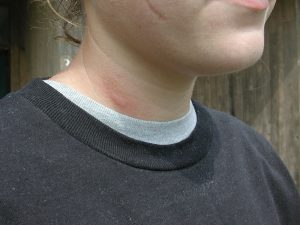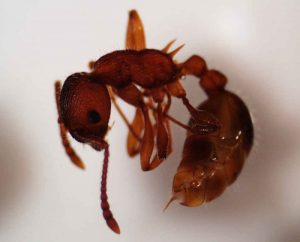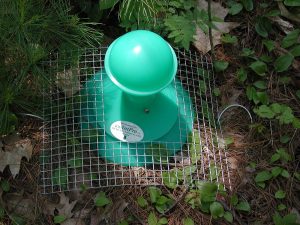Bulletin #2551, European Fire Ant: Management for Homeowners: Least Toxic Management Strategies
By Dr. Eleanor Groden, Professor of Entomology, Elissa Ballman, Research Associate in Entomology and Invasive Species, University of Maine, and Lois Berg Stack, Extension Professor of Ornamental Horticulture, University of Maine Cooperative Extension.
Research supported, in part, by the National Park Service at Acadia National Park.
For information about UMaine Extension programs and resources, visit extension.umaine.edu.
Find more of our publications and books at extension.umaine.edu/publications/.
What are European Fire Ants?
 European fire ants (also known as European red ants, Myrmica rubra) are very small (3/16 inch long) red ants that are a pest for people and a threat to the environment. They aggressively defend their territory and readily sting humans, pets and livestock. They are often found in dense numbers. If European fire ants move into new areas, they displace native ants and other insects. More information can be found in Bulletin #2550, European Fire Ant*: A New Invasive Insect in Maine
European fire ants (also known as European red ants, Myrmica rubra) are very small (3/16 inch long) red ants that are a pest for people and a threat to the environment. They aggressively defend their territory and readily sting humans, pets and livestock. They are often found in dense numbers. If European fire ants move into new areas, they displace native ants and other insects. More information can be found in Bulletin #2550, European Fire Ant*: A New Invasive Insect in Maine
What Can I Do About Them?
It may not be possible to eliminate European fire ants if they have become well established, but you can manage them to reduce their effects, and take actions to prevent their spread. You and your neighbors can work together to manage colonies that span several properties. Never treat property you don’t own.
BEWARE!
Most new infestations are caused when people unknowingly introduce these ants to new areas by moving ant-infested potted plants, soil, compost, wood chips or other organic materials.
DO NOT share or move plants or materials that might be infested without first carefully inspecting them and ensuring that they are free of European fire ants!
Prevention Is the Best Strategy
European fire ants occur in many communities in coastal Maine. If you don’t have European fire ants, carefully inspect all plants, woodchips, compost, logs, and soil before you bring them to your property. If you find ants in potted or balled-and-burlapped plants, either return them to the nursery or isolate them until you can have the ants identified by your local Extension agent.
Ant Identification
 Before beginning any management actions, ants must be identified by a trusted source such as an Extension educator (see above). Many native red ants look like European fire ants but provide important ecological services such as pollination, seed dispersal, and pest control.
Before beginning any management actions, ants must be identified by a trusted source such as an Extension educator (see above). Many native red ants look like European fire ants but provide important ecological services such as pollination, seed dispersal, and pest control.
Identifying Characteristics Include:
- European fire ant’s “waist” has two distinct nodes, with two backward-pointing spines.
- Multi-queen nests have many flat openings, may be hidden under logs or stumps, and can be hard to find.
Manage Without Chemicals
Remove stones, boards, fallen leaves, logs, and other debris to eliminate potential nest sites from your yard or garden. These ants require moist habitats, so reducing irrigation and increasing solar exposure by mowing tall grass and pruning shrubbery may make parts of your property less hospitable to European fire ants.
Manage with Chemicals
Research over the last decade has shown that chemical control is currently the most effective way to suppress ant populations. Bait-formulated pesticides are the most effective treatment. Baits consist of an insecticide blended with sugar, oil or protein food sources. They work better than insecticides applied directly to foraging ants because they are carried back to the nest and fed to queens and brood, thereby killing most ants in the nest.
Insecticide baits also target ants more specifically than broad-spectrum insecticides and have less impact on beneficial insects and other wildlife. You may use baits that are broadcast over an area or delivered in bait stations. We found that broadcasting baits directly onto the ground reduce European fire ant populations much more effectively than using bait stations. However, broadcast applications can expose people, pets, and other non-target animals to pesticides. Most products can be purchased locally at hardware stores.
Note: If you choose to use pesticides, always follow label directions.
When to Manage
Apply insecticide baits in early to mid-summer when ants are feeding heavily. In Maine, treat between June 1 and September 1, when ants forage most actively. Apply baits when temperatures are above 60°F. Do not treat immediately before or after rainfall or irrigation.
What Works Best
The most effective broadcast material we tested contained the active ingredients indoxacarb, hydramethylnon, or spinosad. The most effective bait stations use liquid baits, such as those containing imidacloprid.
Neither homemade nor commercial boric acid products were effective in our field tests. Neither was pouring boiling water on nests or spreading plain cornmeal grit (said to kill ants by swelling in their digestive tracts).
Baits lose their effectiveness when stored. Do not purchase more than you need for one season, but if you have bait left over, it is better for the environment to share it with a neighbor or to save it for the next application, than to throw it away.
How to Apply Granular Baits
 Always read and follow label directions. Spread granular baits evenly using a hand-held spreader or shaker sold for fertilizer and seed application. Application rates vary according to product — follow label directions. Do not apply to vegetable gardens. Take care to prevent granules from landing on impervious surfaces such as paved driveways, from which they could be washed into waterways.
Always read and follow label directions. Spread granular baits evenly using a hand-held spreader or shaker sold for fertilizer and seed application. Application rates vary according to product — follow label directions. Do not apply to vegetable gardens. Take care to prevent granules from landing on impervious surfaces such as paved driveways, from which they could be washed into waterways.
Time Your Treatments
Baited insecticides are slow-acting poisons. It may take several weeks to see results. Products vary in recommended treatment intervals, but generally, baited granular products should not be applied more than once every four weeks.
Broadcast baited granular products using a hand-held seed spreader. See table below for broadcast bait products that were effective in our tests.
How to Use Bait Stations
Although they are not as effective as broadcasting baits directly on the ground, bait stations may be the only fire ant control option in sensitive areas such as where children and pets play or near wetlands. Bait stations also reduce the risk of pesticide run-off. We found that liquid baits are more effective in bait stations than granular baits. Replenish liquid bait stations when bait is depleted or becomes fouled. Dispose of used bait stations according to label instructions.
| Broadcast Bait Product Name | Active Ingredient | Speed of Control | Notes |
|---|---|---|---|
| Advion Fire Ant Bait® | Indoxacarb | Moderate | Most effective product in our field trials. |
| Green Light Fire Ant Control® | Spinosad | Moderate | Organic product, almost as effective as Advion, but not currently registered for use in Maine. |
| Maxforce Complete Granular Insect Bait® | Hydramethylnon | Fast | Works quickly but populations rebound quickly after application. Not effective long-term. |
| Amdro Fire Ant Bait® | Hydramethylnon | Moderate | Deteriorates with age and becomes less effective. |
| Distance Insect Growth Regulator® | Pyriproxyfen | Slow | Insect growth regulator. |
| Maxforce Quantum Ant Bait® | Imidacloprid | Moderate | Toxic to bees — should be contained in bait station. |
All insecticide products are listed as suggestions. We do not endorse or guarantee the success of any product listed in this publication. Product registrations may have changed since this publication was written. Check with the Maine Board of Pesticides Control at www.thinkfirstspraylast.org or 207.287.2731 to make sure the product you are considering is registered for use in Maine. Follow directions and use caution when applying and handling any pesticides.
Information in this publication is provided purely for educational purposes. No responsibility is assumed for any problems associated with the use of products or services mentioned. No endorsement of products or companies is intended, nor is criticism of unnamed products or companies implied.
© 2015
Call 800.287.0274 (in Maine), or 207.581.3188, for information on publications and program offerings from University of Maine Cooperative Extension, or visit extension.umaine.edu.
The University of Maine is an EEO/AA employer, and does not discriminate on the grounds of race, color, religion, sex, sexual orientation, transgender status, gender expression, national origin, citizenship status, age, disability, genetic information or veteran’s status in employment, education, and all other programs and activities. The following person has been designated to handle inquiries regarding non-discrimination policies: Sarah E. Harebo, Director of Equal Opportunity, 101 North Stevens Hall, University of Maine, Orono, ME 04469-5754, 207.581.1226, TTY 711 (Maine Relay System).



